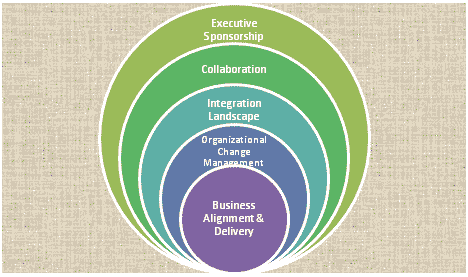Every organization – irrespective of their revenue, number of years in existence, for-profit or not for profit status – has to deal with complex global projects. The global nature of the projects can be due to presence of the organization in various locations or due to the fact that the organization has decided to outsource their applications or business processes. Each scenario has its own set of challenges and issues with delivery. Irrespective of the scenario, there are certain factors every company should take into consideration while managing complex global projects.
Business Alignment & Delivery Management: In a typical setup, these are two different roles. The person responsible for understanding the client needs, maintaining the relationship, analyzing the priorities is different than the person responsible for the overall project delivery. Some organizations tend to have an overall program director that plays both roles. However, managing them as two different roles tends to yield best results. The delivery lead or the delivery director typically comes from inside the organization. He or she is good at pushing back on scope creep, at identifying resources who can deliver and have got a very good working relationship with the executive sponsors. The person who understands the business and builds business relationship can be an outsider. They have deep industry knowledge, they have the expertise to guide a varied group of people with demanding requirements, they are respected for their knowledge and are closely aligned with the delivery teams. The person in charge of business alignment is the so called “good cop” and the delivery manager generally ends up playing the “bad cop”.
Organizational Change Management (OCM): Undertaking a complex global project requires the organization to setup a strong OCM team. Many organizations try to accomplish this task by hiring a change management consultant. In my personal opinion and experience, a change management consultant can help drive the process, define a methodology to handle change and coach the team on various tools and techniques; but they cannot own the complete process and drive the change. The ownership has to lie with an experienced person who has been in the organization for a long time, is respected and knows all the key players and the internal politics.

Integration Landscape: In typical large projects, integration between systems is extremely important. The lead for integration is someone who is technically strong, can think on his or her feet, can come up with alternatives and knows the lay of the land. Another important aspect for the integration lead is to understand the requirements of the subscriber of the data. They should challenge the status quo, stop providing information simply for the sake of providing information, have great knowledge of the architecture and understand the usage of technology. In my mind, the Integration lead is almost like a CTO position. If the organization has the right person, they can really change the landscape of the application environment.
Collaboration Tools & Techniques: A very important factor in managing global projects. Organizations have to make sure they have the right combination of collaboration tools (Chat, Telepresence, Webex, audio conference, etc) combined with the right skill sets. There is no substitute to meeting in person. Projects where the delivery teams meet once every 3-6 months tend to be more successful. Collaboration has become so important that many organizations now even have metrics and incentives for effective and efficient collaboration among project team members.
Executive Sponsorship: So much has been said about executive sponsorship that it is almost a cliché. However, this remains to be a very important factor. Organizations say they have executive sponsorship but it is actions and not words that determine the commitment from the executive team. Large successful projects have had strong participation from the executive team. In a recent project which was considered to be the backbone of the organization, the CFO of a $3billion organization participated in design validation meetings, reviewed the progress on a weekly basis, reviewed the budget on a monthly basis and participated in Executive Steering Committee presentations on a bi-monthly basis. That, in my mind, is true commitment. The presence of the CFO in these meetings compelled the various business unit heads to actively participate and validate the decisions.
As always, what do you think are the key factors? What have you seen work and what has not worked? Please provide your thoughts in the Comments field below.
Copyright © 2010 Sarat Varanasi



Hi Bongani,
Challenges in managing global projects include (from the perspective of a projecct manager in charge of the project):
– lack of strong team building
– ineffective virtual meetings
– unclear roles and responsibilities
– neglect to understand and appreciate cultural diversity
– no clear charter for the team
– lack of clear goals and objectives
– lack of sufficient and clear communication channels
Best regards,
Gina Abudi
What are the real challenges in managing the global projects